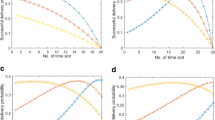Abstract
In this paper, we propose an effective medium access mechanism to enhance performance of the IEEE 802.11 distributed coordination function (DCF). One of the primary issues of 802.11 is a contention-based medium access control (MAC) mechanism over a limited medium, which is shared by many mobile users. In the original 802.11 DCF, the binary exponential backoff algorithm with specific contention window size is employed to coordinate the competition for shared channel. Instead of binary exponential increase, we adopt linear increase for the contention window that is determined according to the competing number of nodes. We also assume that the access point can broadcast the number of mobile nodes to each station through management frames. An analytical model is developed for the throughput performance of the wireless medium. Using simulation results from the NS2 simulator, we show that our model can accurately predict the system saturation throughput, and can obtain better performance in terms of throughput, fairness, and packet drop.








Similar content being viewed by others
References
IEEE 802.11, Wireless LAN Medium Access Control (MAC) and Physical Layer (PHY) Specifications, 1999 Edition (August 1999).
M. Gast, 802.11 Wireless Networks The Definitive Guide (O’Reilly, Sebastopol, 2002).
H.S. Chhaya and S. Gupta, Performance modeling of asynchronous data transfer methods of IEEE 802.11 MAC protocol, Wireless Networks 3 (May 1997) 217–234.
G. Bianchi, Performance analysis of the IEEE 802.11 distributed coordination function, IEEE Journal on Selected Areas in Communications 18 (March 2000) 535–547.
F. Call, M. Conti and E. Gregori, Dynamic tuning of the IEEE 802.11 protocol to achieve a theoretical throughput limit, IEEE Transactions on Networking 8 (December 2000) 785–799.
H. Wu, S. Cheng, Y. Peng, K. Long and J. Ma, IEEE 802.11 distributed coordination function (DCF): analysis and enhancement, in: Proceedings IEEE ICC’02 (May 2002) pp. 605–609.
N.-O. Song, B.-A. Kwak, J. Song and L.E. Miller, Enhancement of IEEE 802.11 distributed coordination function with exponential increase exponential decrease backoff algorithm, in: Proceedings IEEE VTC’03 (April 2003) pp. 2775–2778.
Y. Chen, Q.-A. Zeng, and D.P. Agrawal, Performance analysis and enhancement for IEEE 802.11 MAC protocol, in: Proceedings ICT (March 2003) pp. 860–867.
H. Chen and Y. Li, Performance model of IEEE 802.11 DCF with variable packet length, IEEE Communications Letters 8 (March 2004) 186–188.
C. Wang, B. Li and L. Li, A new collision resolution mechanism to enhance the performance of IEEE 802.11 DCF, IEEE Transactions on Vehicular Technology 53 (July 2004) 1235–1246.
IEEE 802.11e, Medium Access Control (MAC) Quality of Service Enhancements, 2005 Edition (November 2005).
J.W. Robinson and T.S. Randhawa, Saturation throughput analysis of IEEE 802.11e enhanced distributed coordination function, IEEE Journal on Selected Areas in Communications 22 (June 2004) 917–928.
J. Hui and M. Devetsikiotis, A unified model for the performance analysis of IEEE 802.11e EDCA, IEEE Transactions on Communications 53 (September 2005) 1498–1510.
L. Romdhani, Q. Ni and T. Turletti, AEDCF: enhanced service differentiation for IEEE 802.11 wireless ad-hoc networks, in: Proceedings of the IEEE WCNC (2003) pp. 1373–1378.
Z. Tao and S. Panwar, Throughput and delay analysis for the IEEE 802.11e enhanced distributed channel access, IEEE Transactions on Communications 54 (April 2006) 596–603.
X. Chen, H. Zhai, X. Tian and Y. Fang, Supporting QoS in IEEE 802.11e wireless LANs, IEEE Transactions on Wireless Communications 5 (August 2006) 2217–2227.
J. Freitag, N.L.S. Fonseca and J.F. Rezende, Tuning of 802.11e Network Parameters, IEEE Communications Letters 10 (August 2006) 611–613.
Author information
Authors and Affiliations
Corresponding author
Rights and permissions
About this article
Cite this article
Chen, WT. An effective medium contention method to improve the performance of IEEE 802.11. Wireless Netw 14, 769–776 (2008). https://doi.org/10.1007/s11276-006-0012-7
Published:
Issue Date:
DOI: https://doi.org/10.1007/s11276-006-0012-7




